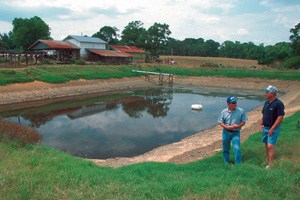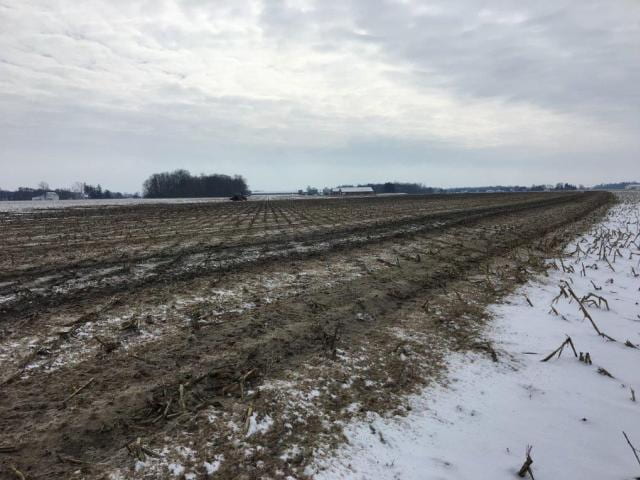 As a county SWCD office we acknowledged the need to help our area farmers and decided to apply for a $250,000 GLRI Grant through the state of Ohio. This grant is focused on reducing nonpoint source nutrient runoff from agricultural source reduction component for subsurface injection of manure and promotion of nutrient management. Our proposed work goal is to reduce nutrient loading to the Auglaize River basin and the Western Lake Erie Basin, specifically, dissolved reactive phosphorus. With this GLRI Grant we will be able to help provide area farmers with equipment to pump out their own manure. Continue reading Allen Soil and Water Conservation District Equipment Rental
As a county SWCD office we acknowledged the need to help our area farmers and decided to apply for a $250,000 GLRI Grant through the state of Ohio. This grant is focused on reducing nonpoint source nutrient runoff from agricultural source reduction component for subsurface injection of manure and promotion of nutrient management. Our proposed work goal is to reduce nutrient loading to the Auglaize River basin and the Western Lake Erie Basin, specifically, dissolved reactive phosphorus. With this GLRI Grant we will be able to help provide area farmers with equipment to pump out their own manure. Continue reading Allen Soil and Water Conservation District Equipment Rental
Manure
Allen County Ag Outlook and Agronomy Day
By Clint Schroeder
Join OSU Extension at the Allen County Fairgrounds, in Lima, Ohio, on Tuesday, February 8, 2022, starting at 9:00 a.m. for the Allen County Ag Outlook and Agronomy Day. The morning session will focus on commodity market outlook and ag policy. In the afternoon you will find answers to your agronomy questions, obtain pesticide applicator and fertilizer recertification credits, and CCA education hours as you prepare for the next growing season. The program will wrap up at 3:30 p.m.
Please RSVP by January 31, 2022 by contacting OSU Extension Allen County at 419-879-9108 or email Clint Schroeder at schroeder.307@osu.edu. The event will be held in the Youth Activities Building on the Allen County Fairgrounds, 2750 Harding Highway, Lima, OH 45804.
Doors open at 8:30 a.m; event starts at 9 a.m. Pre-registration by 1/31/2022 is required and the $15 admission can be paid at the door. Registration fee covers coffee and rolls, lunch, information packet, and education credits.
Manure Science Review Coming August 10th
By Glen Arnold- OSU Extension
The annual Manure Science Review will be held on Tuesday, August 10 from 10:00am to 3:00pm at MVP Dairy near Celina, Ohio. Attendees will see and hear about this state-of-the-art dairy’s 80-cow rotary milking parlor, manure handling and management for the 4,400-cow herd, and regenerative farming practices. Speakers will provide updates on the effectiveness of saturated buffers in reducing runoff in Grand Lake Saint Marys as well as issues of legacy phosphorus runoff and the KDS/Quick wash system for manure nutrient recovery. Field demonstrations will include solid and liquid applicators, the Cadman Side-dress System, Oxbo Equipment, in-season manure side-dress demos, and more.
Continuing education credits have been approved for Certified Crop Advisors, Certified Livestock Managers and Indiana State Chemist certifications. Registration costs are $25 per person until August 1st and $30 per person after that date. For program and registration details, click on the link at ocamm.osu.edu or contact Mary Wicks (wicks.14@osu.edu; 330.202.3533).
Farm Safety Check: Manure Gas
From the Upper Midwest Agricultural Safety and Health Center
Manure-Gas-Farm-Safety-Check-2020  Hydrogen sulfide is a colorless, flammable, and extremely hazardous gas. It is produced by the breakdown of animal wastes or manure. It is heavier than air and can collect in both enclosed pits, open air lagoons and low-lying areas such as, ditches, or manholes. Knowing the risks that can occur with manure gas is important for those farms raising animals and for others who may visit your farm.
Hydrogen sulfide is a colorless, flammable, and extremely hazardous gas. It is produced by the breakdown of animal wastes or manure. It is heavier than air and can collect in both enclosed pits, open air lagoons and low-lying areas such as, ditches, or manholes. Knowing the risks that can occur with manure gas is important for those farms raising animals and for others who may visit your farm.
Take time to protect you, your family and others by incorporating basic principles into your manure management plan and check out additional resources listed below.
SAFETY CHECKLIST
The checklist below lists a few ways you can be prepared in case of a farm emergency:
- Does the storage area have protective fencing and locked gates to prevent anyone not authorized from entering the area?
- Are warning signs posted around the storage area such as “Danger”, “No Smoking” and “Risk of Drowning”?
- Is there an emergency plan in place with phone numbers and addresses posted?
- Has everyone received training about the hazards that exist with manure storage, including the effects of various gases on animals and people, and what to do in an emergency?
- Is Personal Protective Equipment (harnesses or breathing apparatuses) readily available?
- Do you ventilate the pit prior to pumping, during pumping and while working near the pit?
- Do you have a properly working gas monitoring system or device?
- Do you have at least 2 people present when working near the manure lagoon or pit?
You and/or your employee(s) can download and print a pdf checklist to complete safety checks on your farm. Keep the completed forms for follow-up, future reference and inspections.
Here is a link to the PDF version of the checklist. http://umash.umn.edu/wp-content/uploads/2017/11/Manure-Gas-Farm-Safety-Check-2020.pdf
Water Quality Extension Associate Services in NW Ohio
By: Rachel Cochran, Brigitte Moneymaker, Jordan Beck, Nick Eckel, Matthew Romanko, Boden Fisher, OSU Extension
Our Goal
Our goal is to engage farmers and their trusted advisors in new production strategies, technologies, and best management practices to improve fertilizer use efficiency and farm profitability while promoting soil health and reducing nutrient and sediment losses within the western Lake Erie basin.
Through education, outreach, and demonstrations highlighting the benefits of practices we hope to encourage widespread practice adoption and sustained practice implementation.
What We Need Help With
- Learning about the unique challenges that face area farmers.
- Finding partners interested in adopting new technologies and conservation practices and understanding their potential water quality, soil health and agronomic benefits.
- Identifying potential sites for on-farm applied research trials and case studies.
Continue reading Water Quality Extension Associate Services in NW Ohio
Application of Manure to Double Crop Soybeans
By Glen Arnold OSU Extension
Wheat fields will be harvested in Ohio soon and some farmers will plant double-crop soybeans. In recent years there has been more interest from livestock producers in applying manure to newly planted soybeans to provide moisture to help get the crop to emerge.
Both swine and dairy manure can be used to add moisture to newly planted soybeans. It’s important that the soybeans were properly covered with soil when planted to keep a barrier between the salt and nitrogen in the manure and the germinating soybean seed. It’s also important that livestock producers know their soil phosphorus levels, and the phosphorus in the manure being applied, so soil phosphorus levels are kept an acceptable range. Continue reading Application of Manure to Double Crop Soybeans
Ohio Pork Producers and Soil or Manure Samples
The Ohio Pork Council is pleased to announce its partnership with Brookside Laboratories to provide discounted soil and manure samples for all Ohio pig farmers. In an effort to help your operation, Brookside Laboratories has generously offered to provide soil samples for $3/sample and manure samples for $20/sample for all Ohio pig farmers.
After completing a required survey, you will be provided an email with further instructions, a unique identifying code and an order form to be submitted with your soil and manure samples. Special soil sample bags and manure containers will be provided though select integrators and county extension offices.
Continue reading Ohio Pork Producers and Soil or Manure Samples
Winter Application of Manure – Remember Setbacks
By: Glen Arnold OSU Extension Field Specialist
 Some Ohio livestock producers will be looking to apply manure to farm fields frozen enough to support application equipment. Permitted farms are not allowed to apply manure in the winter unless it is an extreme emergency, and then movement to other suitable storage is usually the selected alternative. Thus, this article is for non-permitted livestock operations.
Some Ohio livestock producers will be looking to apply manure to farm fields frozen enough to support application equipment. Permitted farms are not allowed to apply manure in the winter unless it is an extreme emergency, and then movement to other suitable storage is usually the selected alternative. Thus, this article is for non-permitted livestock operations.
In the Grand Lake St Marys watershed, the winter manure application ban from December 15th to March 1st is still in effect. Thus, no manure application would normally be allowed from now until March 1st.
In the Western Lake Erie Basin (WLEB) watershed, the surface application of manure to frozen and snow-covered soils require there to be a growing crop in the field. This could be a pasture, alfalfa, clover, ryegrass or a rape crop. There must be enough vegetation visible to provide a 90% cover of residue and growing vegetation. Radishes and oats would not qualify as a growing crop as both are typically winter killed. Manure can be applied to fields without growing crops if the manure is incorporated at the time of application or incorporated within 24 hours of application. Continue reading Winter Application of Manure – Remember Setbacks
Poultry Litter Applications

By: Glen Arnold OSU Extension
Stockpiles of poultry litter can be seen in farm fields across Ohio. While common each year in wheat stubble fields, there are also stockpiles showing up in preventative plant fields. Poultry litter is an excellent source of plant nutrients and readily available in most parts of the state.
Poultry litter can be from laying hens, pullets, broilers, finished turkeys, turkey hens, or poults. Most of the poultry litter in the state comes from laying hens and turkey finishers. Typical nutrient ranges in poultry litter can be from 45 to 57 pounds of nitrogen, 45 to 70 pounds of P2O5, and 45 to 55 pounds of K2O per ton. The typical application rate is two tons per acre which fits nicely with the P2O5 needs of a two-year corn/soybean rotation.
Like all manures, the moisture content of the poultry litter greatly influences the amount of nutrients per ton. Handlers of poultry litter have manure analysis sheets indicating the nutrient content.
Poultry manure for permitted operations needs to follow the Natural Resource Conservation Service 590 standards when being stockpiled prior to spreading. These include:
– 500 feet from neighbors
– 300 feet from streams, grassed waterways, wells, ponds, or tile inlets
– not on occasionally or frequently flooded soils
– stored for not more than eight months
– not located on slopes greater than six percent
– located on soils that are deep to bedrock (greater than 40 inches to bedrock)
Farmers who want to apply the poultry litter delivered to their fields are required by Ohio law to have a fertilizer license, Certified Livestock Manager certificate, or be a Certified Crop Advisor. Check with your local Soil and Water Conservation District for proper setbacks from steams, ditches and wells when applying poultry litter.
